Crete is dotted with picturesque villages that seem neglected, devoid of human life, as if time has passed them by and left them just as they have been standing for the last few hundred years. The houses are still standing, but the schools have closed; a few old folk can be found sitting in the yards of their stone houses, surrounded by potted plants in recycled metal cheese tins. The new roads now connecting these pockets of settlements came too late.
Urbanisation and rural decline only served to speed up the process of the desertification of the villages in favour of the towns. The few remaining signs of human life in the countryside can be seen once the weather fines up in spring; doors and windows are left open for the fresh air to blow away the musty smells of the winter, letting the sun's rays enter to warm up the stone walls of the houses which will have been lovingly whitewashed. This is the time when the village springs to life (mind the pun).
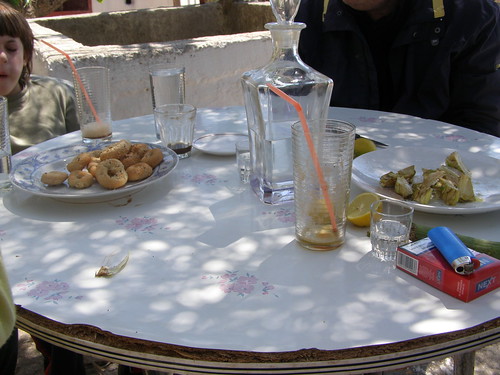
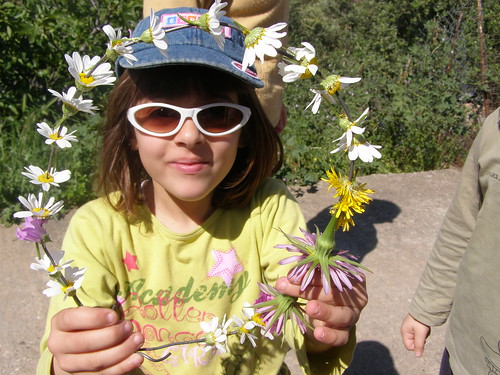
Hors d'oeuvres in Ramni (artichokes, paximadi and tsikoudia); the May Day custom is to make flower wreaths and display them in public, to show that
'you caught May' (πιάσαμε το Μάη - piasame to Mai)
May Day may be viewed as an international celebration of the labour movement, but in Greece, it is synonymous with the countryside. Protomayia is spent away from the town, close to nature, in fields covered with wildflowers. The countryside is teeming with so much activity on this day that it may seem as though it was never deserted in the first place.
We had been arranged to go out for lunch on May Day with a close friend and his family. We let him choose the taverna; he gave us the name of a village instead. Hiliomoudou (Χιλιομουδού) is a tiny and rather insignificant-sounding community located near the foothills of Lefka Ori (the White Mountains) in Hania. It isn't hard to find, as long as you know the village located before it, and the others located before that one. We followed our friend's car.
The population of Hiliomoudou was given as 47 in 2001; it is hardly likely to be even half that now. But those who have stayed on in Hiliomoudou do not need to feel isolated. On the 1st of May, the village burst into life: the aromas of traditional Cretan food were wafting in the spring breeze, the sound of the Cretan lyra was echoing among the hills, and the cars entering and exiting the area even caused a traffic jam on the narrow road leading in and out of the village.





The wildflowers created a rainbow effect on the green foliage of the evergreen olive trees that Hania is commonly known for.





The community of Hiliomoudou belongs to the municipality of Armenoi (Αρμένοι), an area well known from Byzantine times. This area includes coastal town of Almirida (Αλμυρίδα), where the last battle against Ottoman rule took place, in Crete's bid for independence. The area is full of rustic charm, with all the romantic elements of the Cretan countryside - wild nature, islated country dwellings, and picturesque churches abound; it is easy to understand why this place has attracted so many ex-pat British retirees who are renovating unwanted houses which they bought cheaply (and adding that monstrοsity of edifices, the swimming pool, to each one; at least that's what was happening before the economic crisis).
The Byzantine church of St Nicholas, in Kyriakoselia (Κυριακοσέλια), another tiny community neighbouring Hiliomoudou, is one of the oldest and best preserved in all of Crete. The gates leading to the church are always open, ready to welcome visitors. The well kept cemetery surrounding the church signals life, not death; the tombs are clean and tidy, full of fresh flowers (or new plastic flower wreaths), a sure sign of recent human activity, even if human beings are not always in its proximity.
A kilometre or so away, perched on the side of a rock, the church of St Mamas has been built over a cave. Its appearance is very striking as it juts out from the rock face.
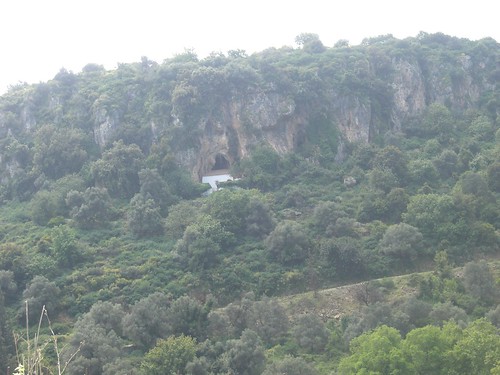
The whitewashed walls of St Mamas church are conspicuous situated on the face of a rocky hill, making it hard to miss as you drive past.
Although the name Mamas (the name of an animal-loving child saint) is never heard in Crete, there are quite a few churches dedicated to his name; St Mamas is also celebrated in other parts of Southern Europe.
It was full house at Taverna Lemonia in Hiliomoudou on May Day; half the tables had been reserved before the day. The tables were arranged outdoors on a covered verandah, with a stage set up for the musicians. A male lyra player has a certain crowd-attracting sex appeal to Cretans that can only be explained as a cultural idiosyncracy. The tall handsome singer (a epitome of a Cretan λεβέντη - leventi) was a definite crowd pleaser; he played the part of the troubadour very well, right down to his gait. Cretan music has developed modern rhythms and themes, although the sound is still distinctly Big-Islandish, using the Cretan accent as well as dialectal words and phrases. Despite being urbanised, Cretans love to break out in their own lingua when in company; Cretan Γreek was being head and spoken in the whole taverna.


Saganaki (fried cheese), thickly cut fried potatoes, tzatziki and horta...
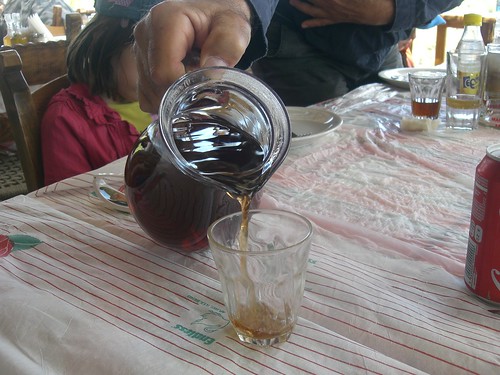
... followed by lambchops and plenty of good wine...
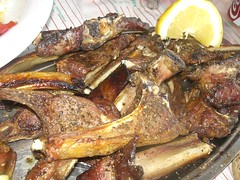

... and ending with quince desert in syrup (a desert of some kind is always offered 'on the house' in most Greek tavernas at the end of a meal; deserts are hardly ever a menu item)
The food was practically all grown (or raised) and cooked in the village; the democratic menu which everyone could afford was limited to local specialties cooked according to Cretan tradition: stmanagathi, snails, staka, kalitsounia, tsigariasto. There were also a few standard national favorites, just to remind us all that we were not just Cretans, but also Greeks: BBQ pork steak and lambchops, tzatziki, Greek salad. The emphasis, as always in Cretan cuisine, is not on the variety but on the quality. The aromas of the food left a scent trailing from the kitchen to the tables; everything tasted fresh, and no wonder, since most of the traditional ingredients used in the meal were nearly all grown and/or raised within 10 kilometres of the taverna.
Best bread I've eaten in years - the flour was freshly ground by windpower at the taverna.
Like all modern enterprises, Taverna Lemonia uses its own unique gimmicks to attract business. The owner has built a fully functioning windmill on the site, which begins to turn as soon as a breeze picks up on the little hill where the taverna is located. And what a hill that is, offering a panoramic view straight out to the sea to the north of Hania.
Flour is milled here, which gets turned into the bread served at the taverna, while most of the meat is raised from the farm animals kept on the land below the premises. The area is well known for local wine production (not bottled wine), and today, it was top-notch.
The customers of the taverna were a mixed and varied bunch. As the concert had been widely advertised, nearly everyone was a local (in the wider sense), but the crowd still lacked homogeneity. What bound them all was their cultural identity, pride in their heritage and love of traditional meals. All age groups were represented, but those who stood out were the man with the big silver earring (speaking in Cretan) and the young lady who came accompanied by her dog on a leash, both of which would have been frowned upon in earlier times. Could this be a sign of globalisation and foreign trends infiltrating Crete's unique culture? No, not at all. More likely a case of ο καθένας με τα γούστα του' (o kathenas me ta gousta tou; each to his own).
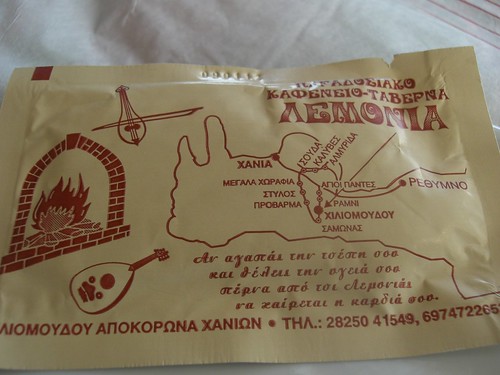
A mantinada is printed on the wet towel packaging:
"If you love your pocket, and you want good health
pass by Lemonia and your heart will flutter with joy."
For 9 people, we ordered 2 servings of horta, 1 greek salad, 2 of roast lamb and potatoes, 1 tsigariasto, 4 pork steaks, 2 saganaki, 2 tzatziki, 3 plates of fried potatoes, 1 kilo of lambchops, 1 litre of wine and 6 soft drinks; total cost €117.
This one is for you, Vaso, because I know how much you would have liked to be at Hiliomoudou with me today.
©All Rights Reserved/Organically cooked. No part of this blog may be reproduced and/or copied by any means without prior consent from Maria Verivaki.
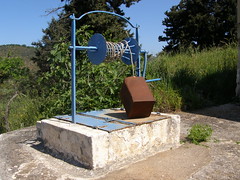

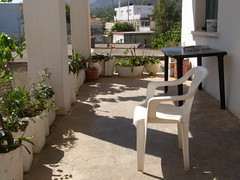
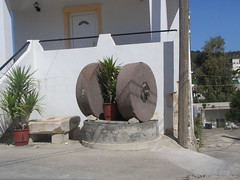

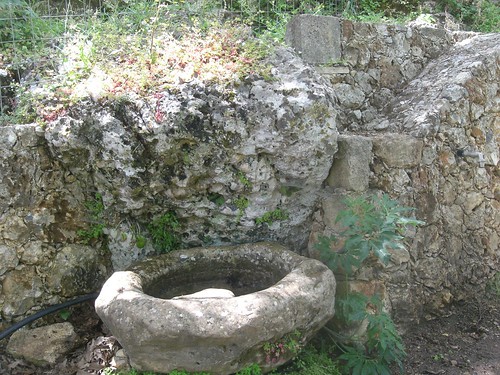
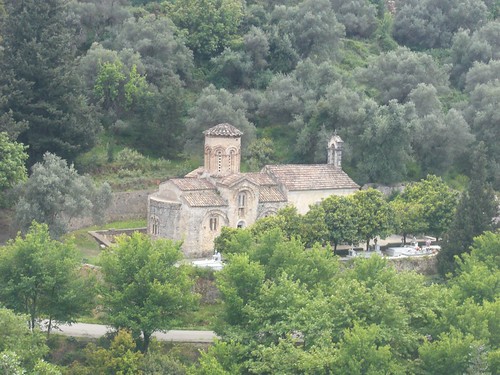
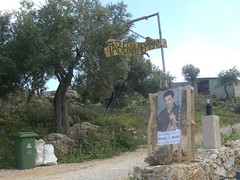
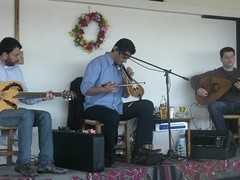

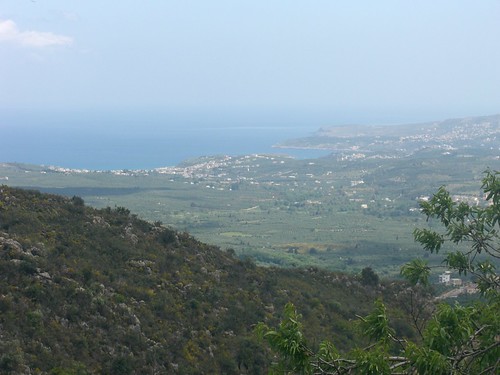

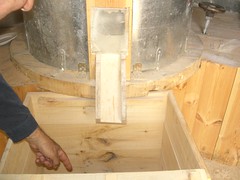

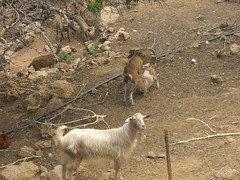
I am so jealous! Especially for the bread... my mother-in-law used to bake her own bread at home in her wood burning oven. I have never tasted again such a tasty bread!
ReplyDeletePretty flower wreath.Its blooming in this part of the world too.Yummy!I long to eat such fresh locally grown food ,everything from meat to bread.
ReplyDeleteOh my gosh, your May day celebration looks wonderful! I'm totally enraptured by the photo of St. Mamas. The countryside there is so very beautiful. Looks like it's warm and sunny there, too. And, the food! YUM!
ReplyDeleteThe countryside and flowers are so beautiful, as was the layout of food! The fresh bread and locally grown food looks so delicious. The music was delightful; thanks for a peek into your May celebration!
ReplyDeleteWhat a day you had, Maria! Beautiful post. Oh how much I like the photo of the windmill, so lovely!! I can imagine the heavenly taste of that bread...
ReplyDeleteThis is all so amazing!
ReplyDeleteMaria mou seuxaristw polu ....egw phga sto levin....gia na dw thn Estelle Rolfe ...einai filoi me to theo sou Mixalh kai th thea Dhmhtra..me rwtouse gia sas ..eixe gnwrisei kai to mpampa sou ekei..perasame wraia..!!!!!!alla 3exasa na kanw mah..!!!!!!vaso
ReplyDeleteDear Maria,
ReplyDeleteAll so wonderful. A beautiful springtime, a festival of it and wonderful food...
Then you posted that incredible fried cheese. Reminds me so much of haloumi (yes, now made and available here, i.e. decent stuff made here not all snatched up by chefs) - and even a decent sized wedge of lemon beside to drizzle all over. Drooling......
With a start like this I expect the rest of your weekend to be glorious.
Zebbycat is stretched out in front of the warm heater. The forecast = "light occasional overnight showers", so the showers are torrential......
Wellington hasn't changed weatherwise, dear Maria (umbrellas still useless!)
Happy cooking and eating, Michelle and my much loved Zebbycat xxx
nothing would make me happier then visiting a place time has passed by. Especially in the spring. Visited the flowers. Crete reminds me of California in many ways.
ReplyDeleteSuch marvelous photos of both scenery and food! St. Nicholas Church is beautiful - what a vantage point from which the picture was taken. May Day is not celebrated nor recognized in any official capacity here except that it has become a day for small demonstrations throughout the country for immigration rights (primarily a movement among Hispanic communities). I prefer to honor it as a day as Cretans do - a day to celebrate nature's resiliency and bounty.
ReplyDeleteThis was a great post! I loved all of you pictures and as always, your writing. You have managed to carry us with you through your day once again. Thank you, it was lovely.:)
ReplyDeleteWhat a fantastic post, as Cheryl said both writing and photos. I can almost imagine myself there! (I can dream ....!)
ReplyDeleteHappy May Maria!
ReplyDeleteI greatly enjoyed your post, and I am wondering what are the yellow flowers (in you series of flower pics above) in the 1st pic from the second row. Do you know?
Beautiful pics and awesome write up. Definitely going to have to search itunes tonight for more Cretan music.
ReplyDeleteMaria, what a wonderful Protomagia Day and again, your choice of tavernas is making me so hungry!
ReplyDeleteKalo Mina Maria. It sounds like a terrific taverna to visit. Must have it in mind next time I visit Chania.
ReplyDeleteAnother great post maria!
ReplyDeleteGreat to read about the villages and to get some info about Crete. I am traveling to Crete next week, so this really helps me to get an overview! Thanks!
ReplyDelete